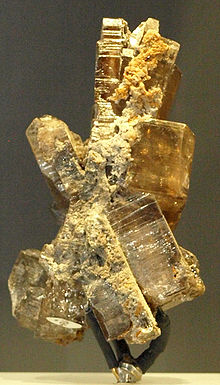Phosgenite
H-M symbol: (4/m 2/m 2/m)
Phosgenite is a rare mineral consisting of lead carbonate chloride, (PbCl)2CO3. The tetragonal crystals are prismatic or tabular in habit: they are usually colorless and transparent, and have a brilliant adamantine lustre. Sometimes the crystals have a curious helical twist about the tetrad or principal axis. The hardness is 3 and the specific gravity 6.3. The mineral is rather sectile, and consequently was earlier known as corneous lead, (German Hornblei).[6]
Name and occurrence

The name phosgenite was given by August Breithaupt in 1820, after phosgene, carbon oxychloride, because the mineral contains the elements carbon, oxygen, and chlorine.[6]
It was found associated with anglesite and matlockite in cavities within altered galena in a lead mine at Cromford, near Matlock: hence its common name cromfordite.[7] Crystals are also found in galena at Monteponi near Iglesias in Sardinia, and near Dundas in Tasmania.[6] It has also been reported from Laurium, Greece; Tarnowitz, Poland; the Altai district, Siberia; the Touissit mine, near Oujda, Morocco; Sidi Amor ben Salem, Tunisia; Tsumeb, Namibia; Broken Hill, New South Wales; and Boleo, near Santa Rosalía, Baja California Sur. In the US it has been reported from the Terrible mine, Custer County, Colorado; the Stevenson-Bennett mine, Organ Mountains, Doña Ana County, New Mexico; and the Mammoth mine, Tiger, Pinal County, Arizona.[3]
Crystals of phosgenite, and also of the corresponding bromine compound PbBr2CO3, have been prepared artificially.[6]
See also
- Barstowite, another lead chloride carbonate
References
- ^ Warr, L.N. (2021). "IMA–CNMNC approved mineral symbols". Mineralogical Magazine. 85 (3): 291–320. Bibcode:2021MinM...85..291W. doi:10.1180/mgm.2021.43. S2CID 235729616.
- ^ Mineralienatlas
- ^ a b Handbook of Mineralogy
- ^ Mindat.org
- ^ Webmineral data
- ^ a b c d
 One or more of the preceding sentences incorporates text from a publication now in the public domain: Spencer, Leonard James (1911). "Phosgenite". In Chisholm, Hugh (ed.). Encyclopædia Britannica. Vol. 21 (11th ed.). Cambridge University Press. p. 474.
One or more of the preceding sentences incorporates text from a publication now in the public domain: Spencer, Leonard James (1911). "Phosgenite". In Chisholm, Hugh (ed.). Encyclopædia Britannica. Vol. 21 (11th ed.). Cambridge University Press. p. 474. - ^ "Phosgenite and Matlockite in Derbyshire (Part 1). T. Bridges, M. E. Smith. Journal of the Russell Society Volume 1, No. 2, p.7–14, 1983 Retrieved on 2011-01-11













